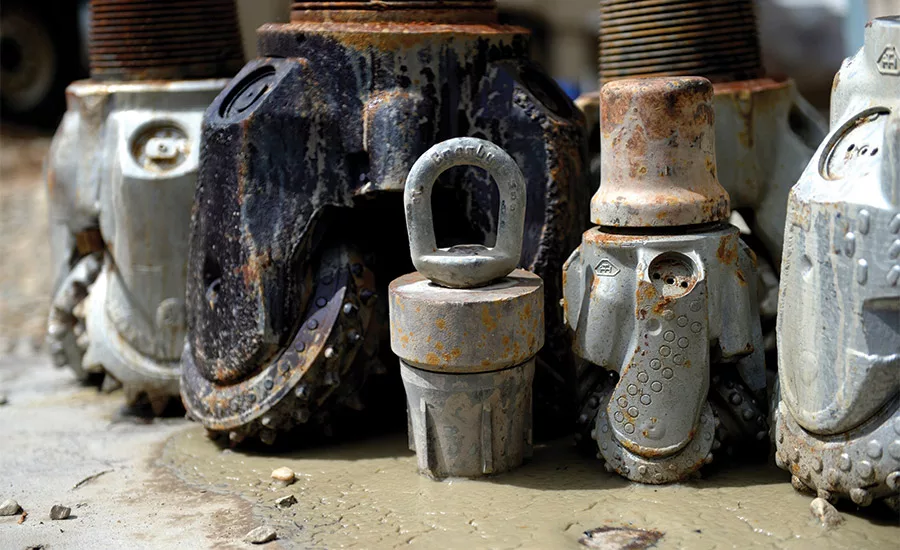Tactics for Balling on Tricones, Wing Drilling Bits

Once they get in formation, bits can have a lot to say to the drillers running them.
Source: Public Domain
One thing every well we drill has in common is that the bit must get to the bottom of the hole. Some formations drill faster than you can clean the hole. Others, not so much. No bit is designed for every formation. Sometimes, most of the hole is one formation, but with streaks of a different formation the bit is not designed for. You know you have to get through it, but the bit does not cooperate. Reading the signs that the bit sends you becomes crucial to telling what you are drilling in, and how to treat the bit.
For example, on the Texas Gulf Coast, most aquifers are cemented sand with a gumbo of clays above it. Drilling there, we usually ran wing bits and very little in the way of mud additives. The clays would quickly build viscosity. Feedback from our bits told us we had to pump off often and use thinners to thin the mud.
Clues we get at the rotary table or tophead reveal a lot. They can tell us about a formation change or, other times, problems downhole. For example, if the bit gradually slows down, this could be a sign of wear.
If the bit is a tricone, and has drilled several wells, I hope you took a good look at the cutting structure and, more importantly, the bearings before you ran it back in. A lost cone is no fun to fish, and wastes time and money. If you run a bit that you figured would make “one more hole” and it suddenly quits drilling, it’s time to pull it. The cutting structure may be shot, or a cone locked up. Either way, it’s trip time. If you do leave a cone in the hole and have to fish, I’d suggest a “poor boy basket,” which I’ve written about before. They are not very expensive or hard to build, and recover bit cones better than most fancy fishing tools.
Occasionally, even a new bit will “ball up” and the cones quit turning. If you pour the weight to it and try to finish, chances are you will flat-spot the bit and junk it. Clues include increased pressure, little or no penetration, and decreased torque. That’s not a misprint: A balled-up bit sometimes turns very easily, but just doesn’t make hole. When this happens, the first thing is to pick up off bottom and circulate as much mud volume as you can. Rapidly stroke the drill pipe up and down to increase the annular velocity. This can (hopefully) wash the clay ball off the bit.
If it doesn’t, after 10 or 15 minutes of high-volume circulation, try gently spudding the bit into the bottom of the hole. The purpose is to get the teeth of the bit to bite into the formation and turn. Even just a few turns will cause the cones to cut up the clay ball, so you can circulate it out and continue drilling.
Another trick is to circulate a couple handfuls of crushed walnut shells. They will cut a clay ball quickly, and circulate out easily. This trick is best if you are running an unjetted bit. Jets can plug easily, depending on size, and then you get the joy of a wet trip out of the hole.
Of course, drillers don’t use only tricones, so let’s look at tactics other options.
Wing bits and composite bits, unlike their tricone cousins, don’t like spudding. It folds wings, and fractures or shears cutting structures. When these types of bits ball up, pick up off bottom, circulate at maximum and spin the bit. If you can get it going fast enough to go into harmonic vibration, it may break up any balling, but this is hard on tool joints. The speed of harmonic vibration depends on drill pipe size, depth and a few other things, so you may not attain that speed. If you can, it usually only takes a few minutes to shuck the ball on the bit. On my little Mayhew, about 150 rpms would get the pipe vibrating like a guitar string. I didn’t like to do it, but it usually worked within a minute or two. Then just go back to bottom and resume drilling.
I find that, besides some difficult formations, bit-balling issues often result from improper speed or weight. I would mark off about 6 inches of Kelly, and time drill it. Then I would change either the speed of rotation or the weigh on bit. After a few trials, I could find the fastest speed and weight for that formation. Of course, the formation is going to change in a few feet, so you have to pay attention to the clues. Don’t sit in the truck talking to your girlfriend while the joint drills down.
I don’t think this is as bad a problem in some parts of the country, but I’ve drilled within a few miles of the Gulf of Mexico and the Atlantic Ocean all the way from Brownsville, Texas, to Myrtle Beach, South Carolina, and seen balling clays almost everywhere. Hope this helps. If you need free advice, send me a message. It’ll be worth what you pay for it.
For more Wayne Nash columns, visit www.thedriller.com/wayne.
Looking for a reprint of this article?
From high-res PDFs to custom plaques, order your copy today!

